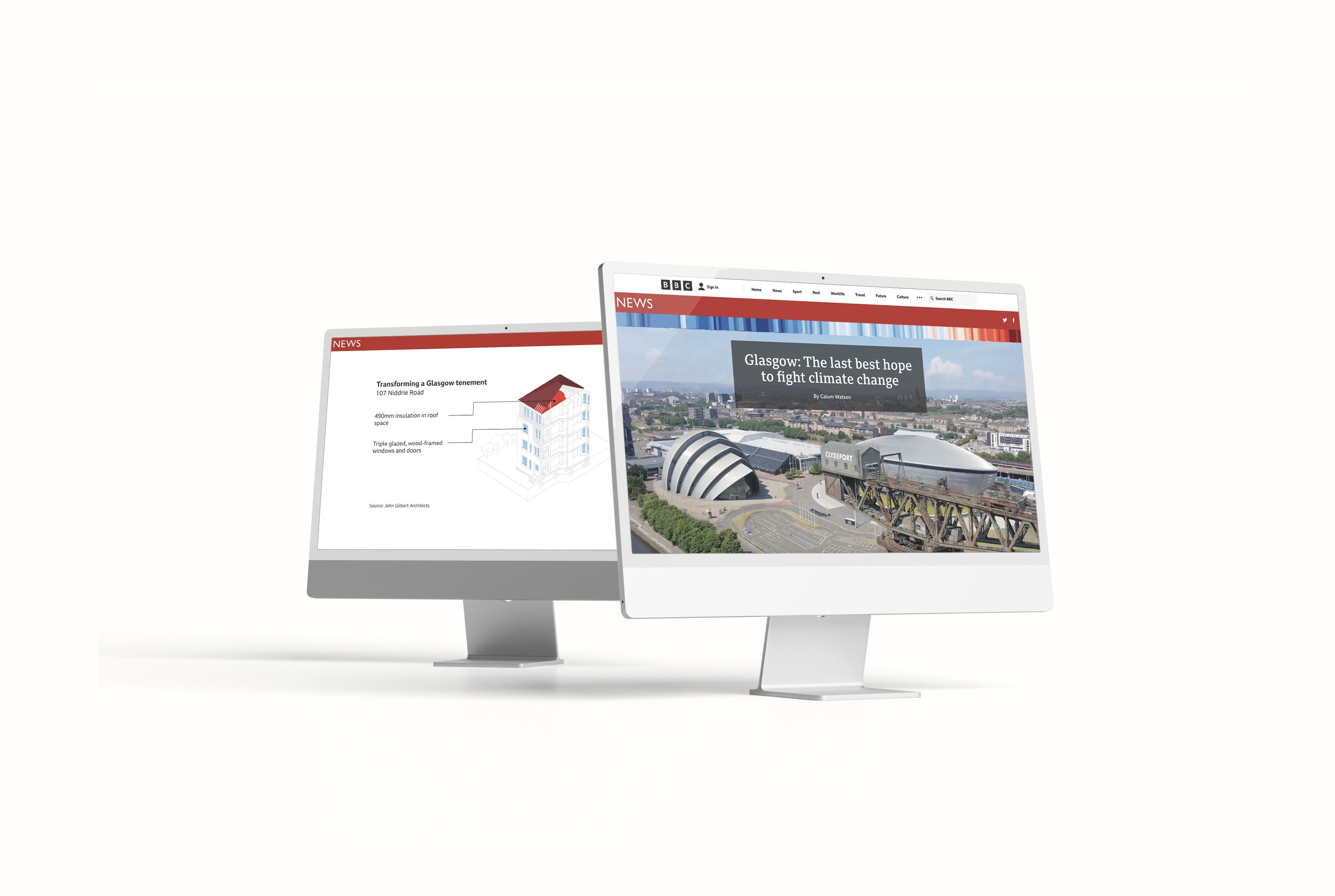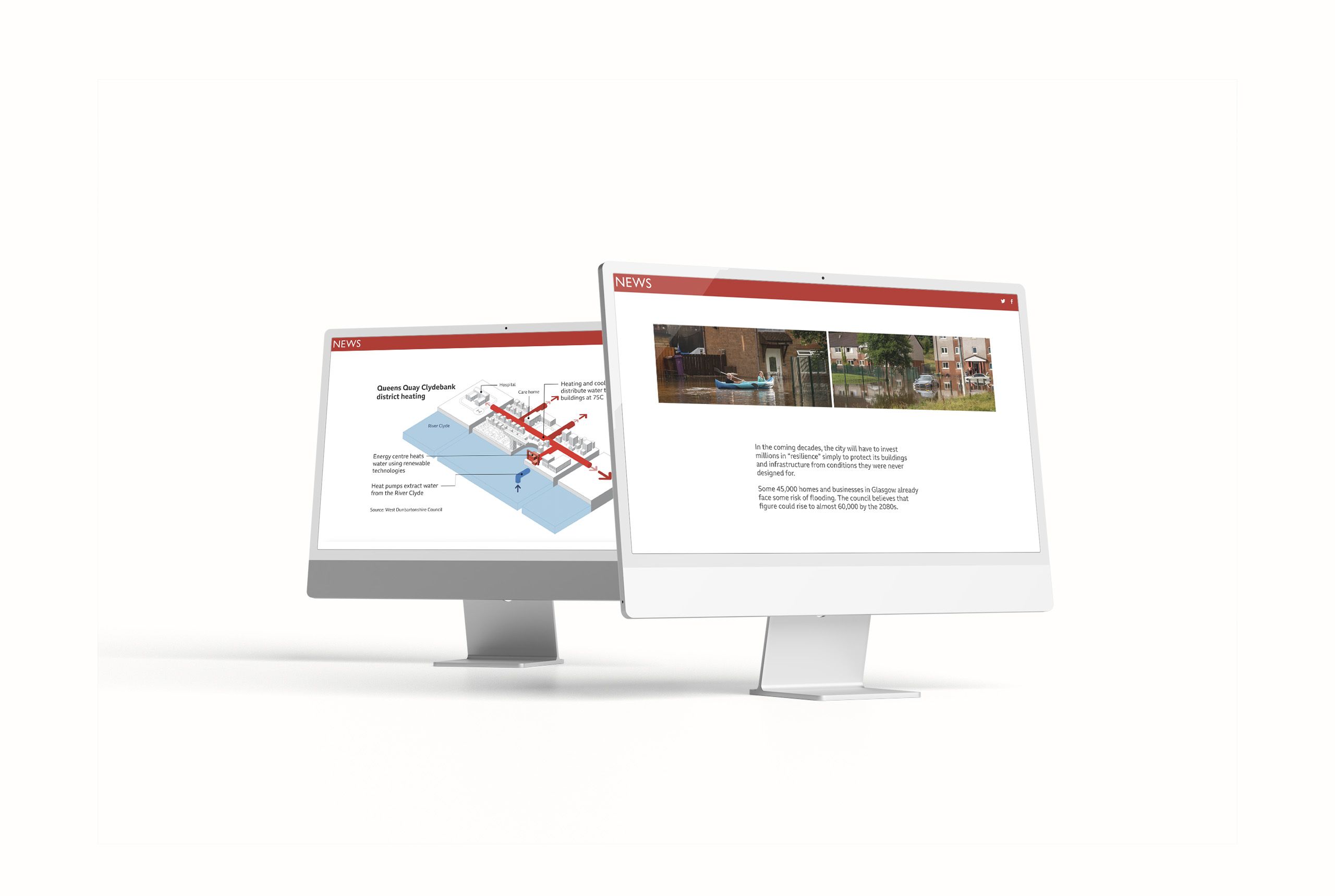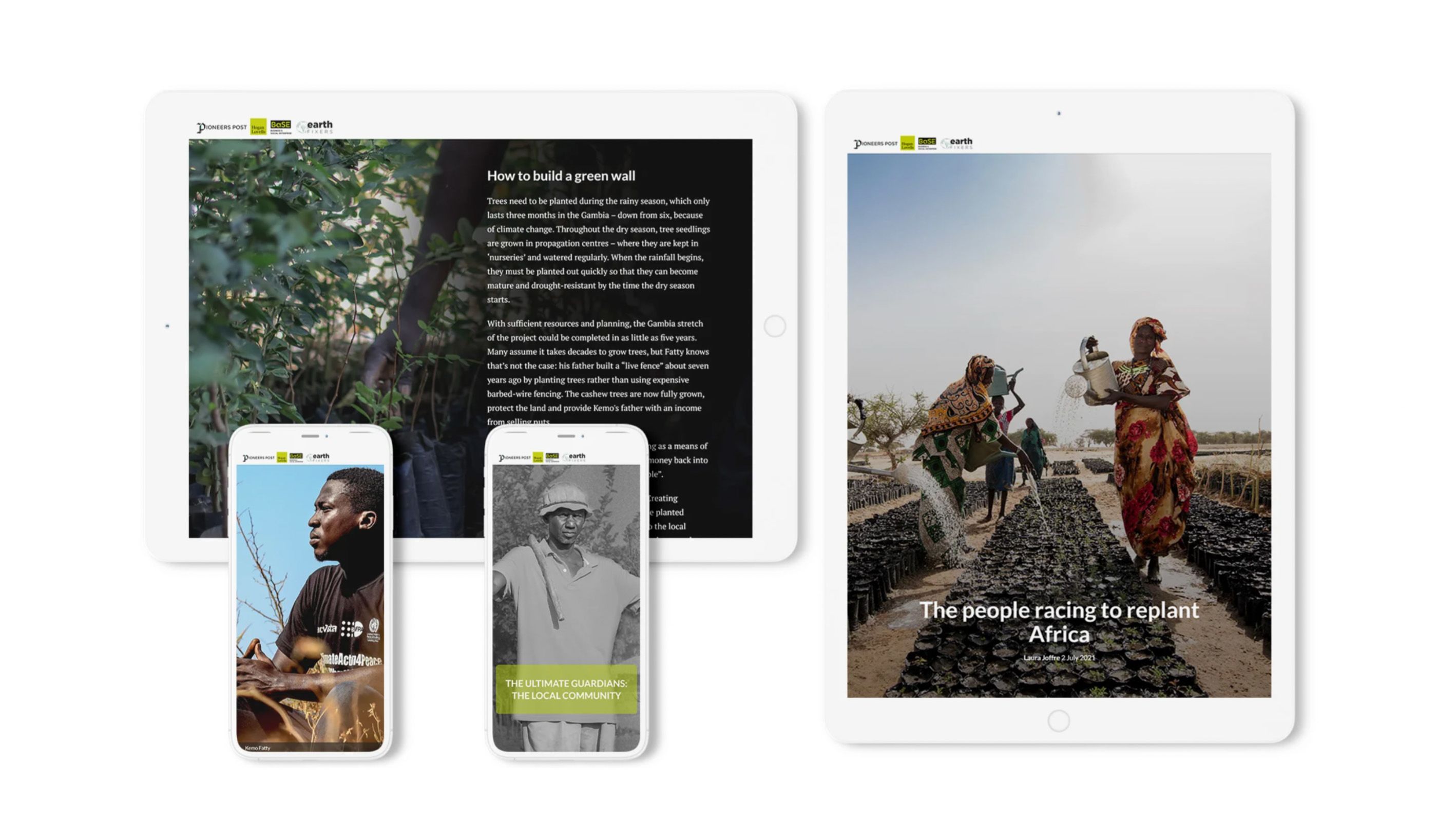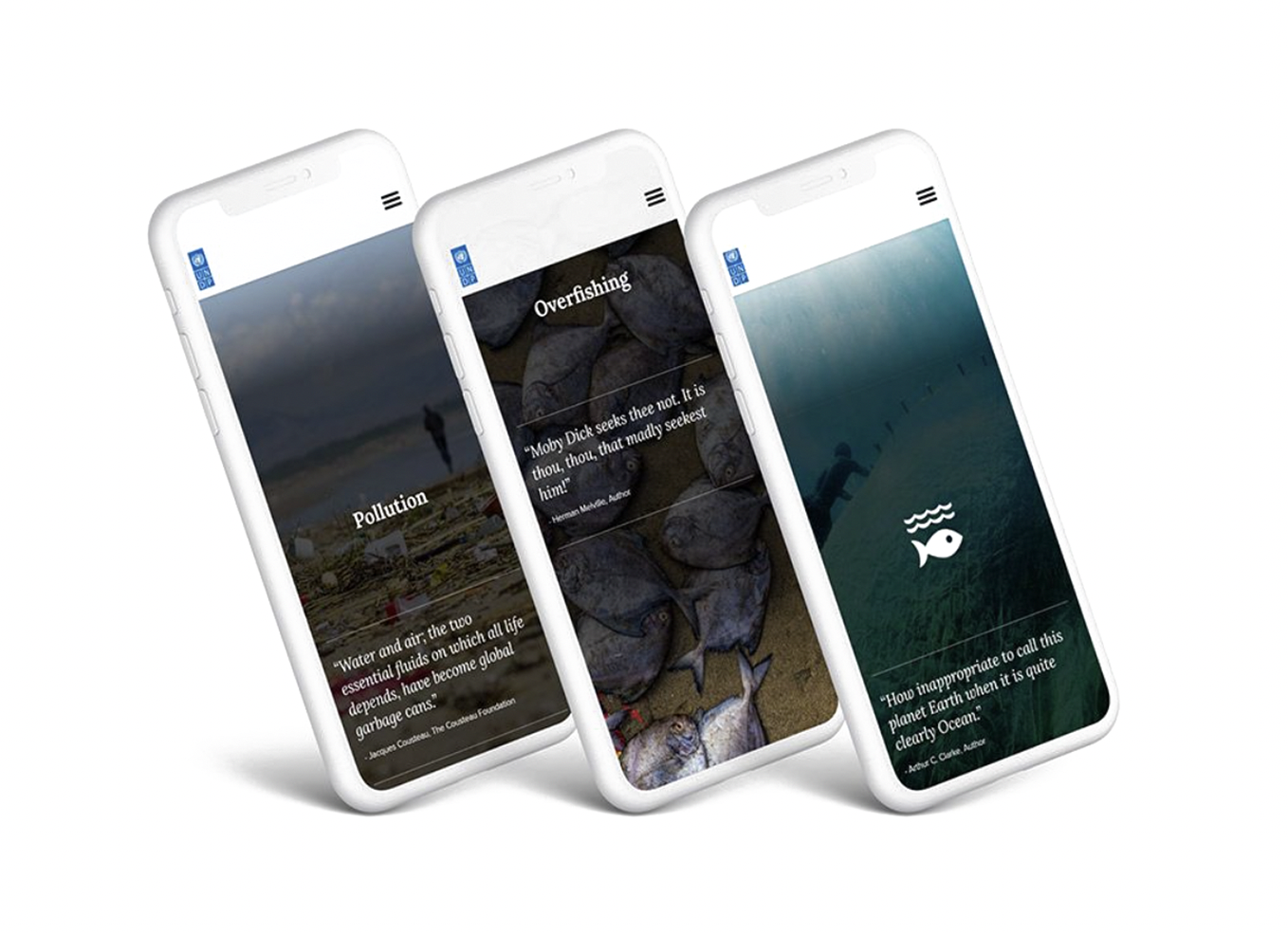9 powerful stories about climate change
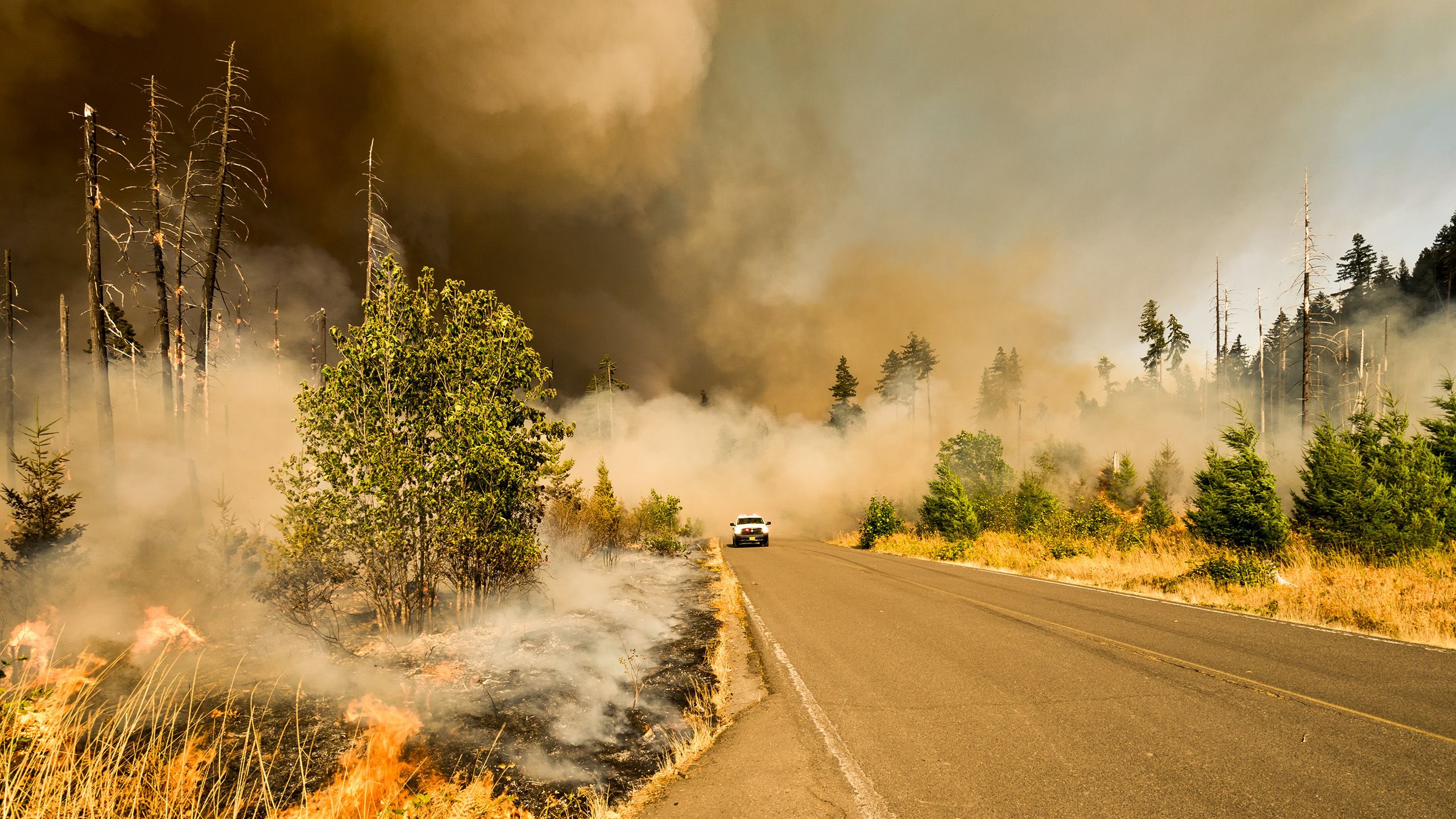
Climate change: two small words that represent a radical transformation of our planet, billions of data points, millions of climate scientists and campaigners, and a limitless number of stories from around the world.
by Corinna Keefe
Climate change stories are the best tools we have to help people understand the climate emergency and take action — whether you have research to share, work for a non-profit, or shape government policy to reduce carbon emissions and fossil fuel use.
But we still face the barriers of misinformation, apathy, climate denial, and slow-moving responses. As the effects of climate change begin to be felt, engaging science communication has literally become a matter of life or death. When we tell climate change stories, we need to reach people on an intellectual and emotional level, using all the digital storytelling tricks at our disposal.
In the examples below, we celebrate some of the best climate change stories on the web. We look at what makes them work, and how you can tell stories about our changing climate that will make a difference.
We'll cover:
Start creating with Shorthand
It's the fastest way to publish beautifully engaging digital magazines, reports, internal comms, and more.
Storytelling and climate change
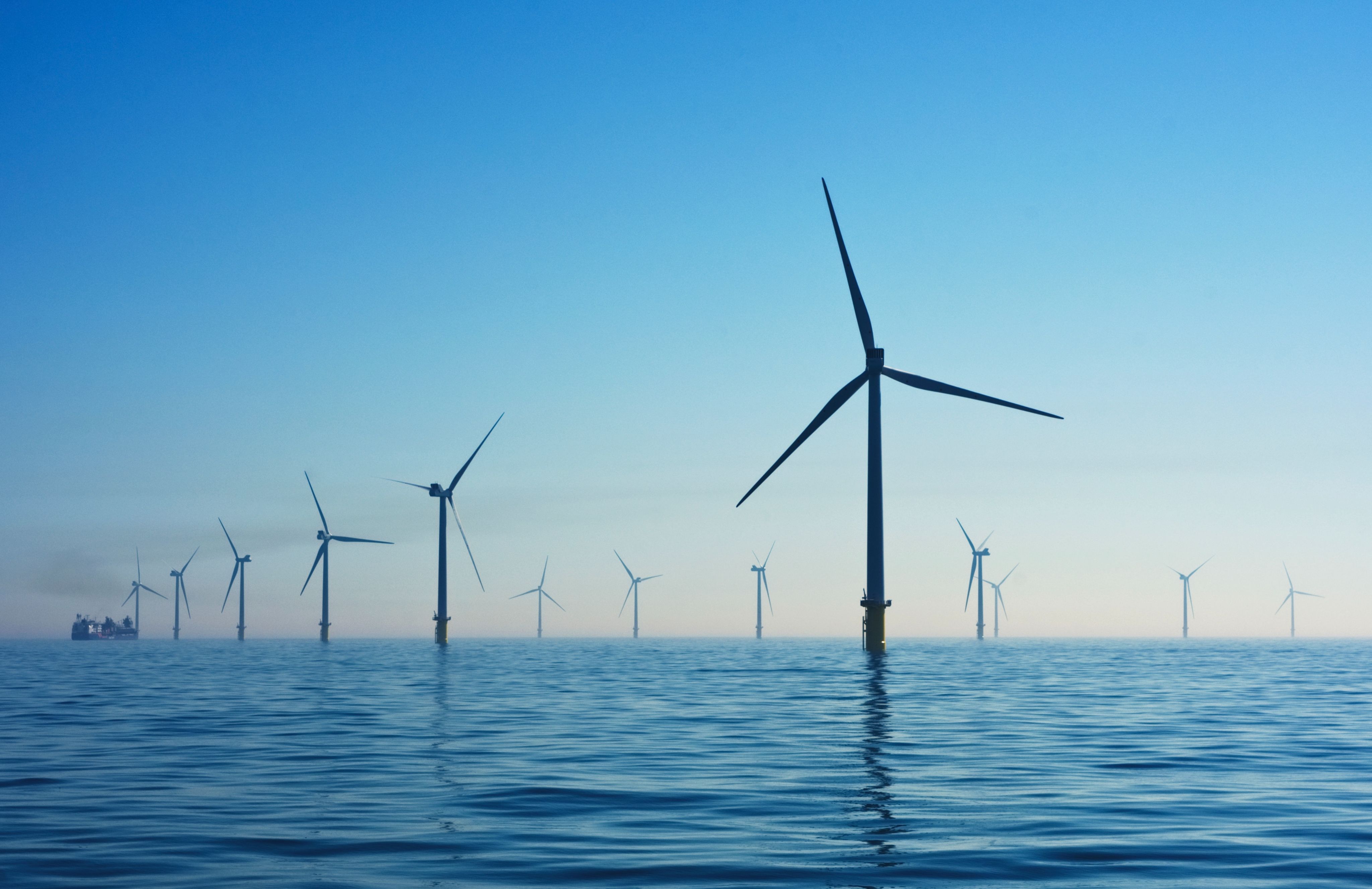
Scientists, policy-makers, and campaigners have already learned that the bare facts are not enough. The Intergovernmental Panel on Climate Change (IPCC) climate reports — which model rapid reductions in greenhouse gas emissions like carbon dioxide to limit warming below two degrees celsius — have been well reported.
People can be shocked or scared by data — but they are rarely moved, inspired, or excited.
But climate change stories (with data to back them up) can influence people towards climate action. Engaging feature stories with an emotional appeal and human interest can have real impact.
The vast majority of people these days are aware of global warming, often from seeing the impacts of climate change in their own lives — from heat waves to extreme weather events. They’re just not sure how to respond. When you tell a story about climate action, you offer a guide for people who want to help in the fight against climate change.
Science communication and climate change stories
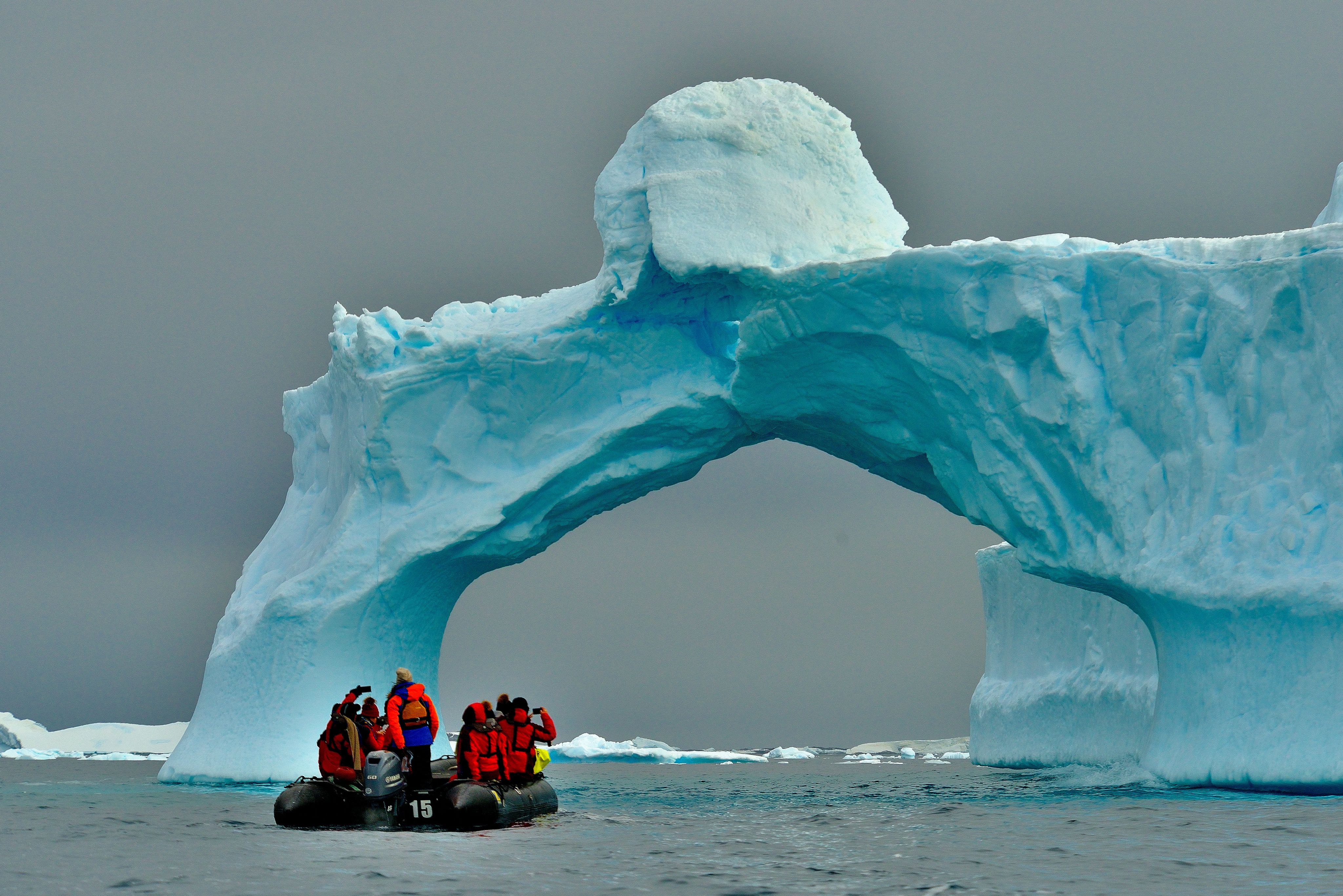
We’ve known about the climate emergency for decades. But it’s taken some time for science communication and data journalism to catch up.
A lot of climate research and data remains closed off to the public. It appears behind paywalls, written in complex academic language, and often presented as inaccessible scholarly publications. The science itself might be thrilling — but the communication leaves something to be desired.
That approach is no longer good enough, for several reasons:
- Most scientific research is ultimately funded by the public. So it should be accessible to the public, too.
- Poor science communication slows down climate action, because people don’t understand the research or simply don’t hear about it.
- We know that different people process information in different ways — whether they’re visual, aural, or even kinaesthetic learners. Visual storytelling and creative science comms are completely valid ways to present research. 'Serious' doesn’t have to mean 'Times New Roman, 12pt, black and white'.
When scientists and climate campaigners go the extra mile to tell climate change stories, they get results. Opening up data to the public, using images and video, and finding a human angle to research can all make a big difference.
In an article for The Conversation, communications expert Kamyar Razavi identified several key elements of effective climate change stories.
- Clear communication of the facts about global warming. Data storytelling is a key part of climate stories.
- An appeal to readers’ emotions, both positive and negative. Fear, grief, and anger are all appropriate responses to the climate emergency; but hope, determination, and wonder can be even more motivating.
- Everyday protagonists that readers can recognise and relate to. Stories about local people taking action on local problems are often the most inspirational.
- Open and honest communication about the impacts of climate change and the challenges ahead.
With those elements in mind, we’ve picked out 9 climate change stories which are examples of great science comms. They’re taken from news sites, NGOs, universities, and governments. Most importantly, they’re creative, memorable, emotional, and use all the features of digital storytelling to engage readers.
9 powerful climate change stories

Down under: the community most-exposed to sea-level rise is also one of the poorest (Stuff)
The opening paragraphs of this climate change feature read like a true-crime story.
And according to some residents of Dunedin, that’s exactly what it is.
Catastrophic flooding in this New Zealand community is the final chapter in a long story of climate change, poor urban planning, and socio-economic deprivation. This is a disaster that didn’t have to happen, and many people share the responsibility.
The mechanics of flooding and sea-level rises can be complex to explain. This reporting uses animated map overlays and diagrams to show the science, matched with photographs and videos from Dunedin residents whose livelihoods have been impacted by the floods. It’s a powerful mix of data and experience that stays with the reader.
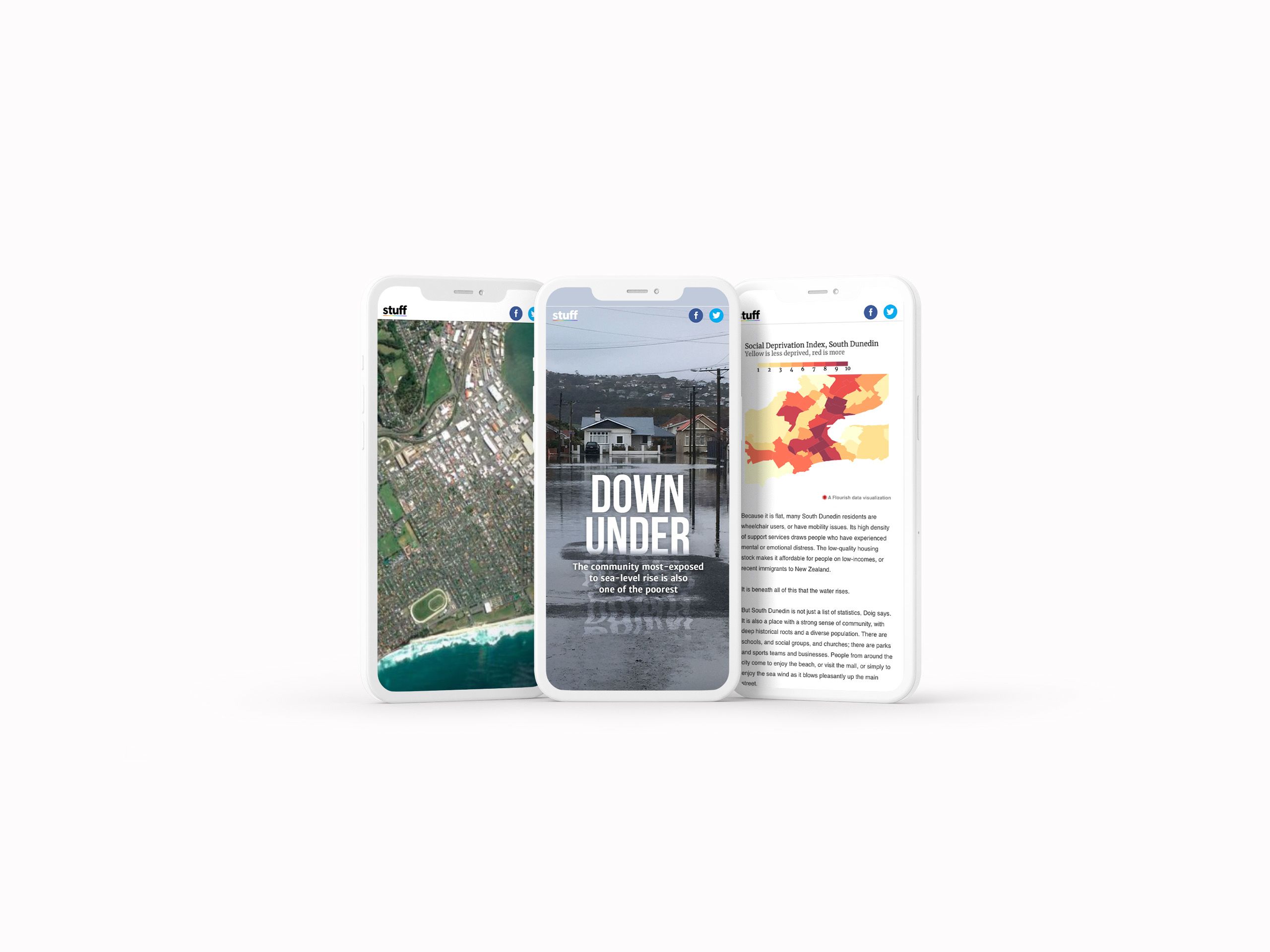
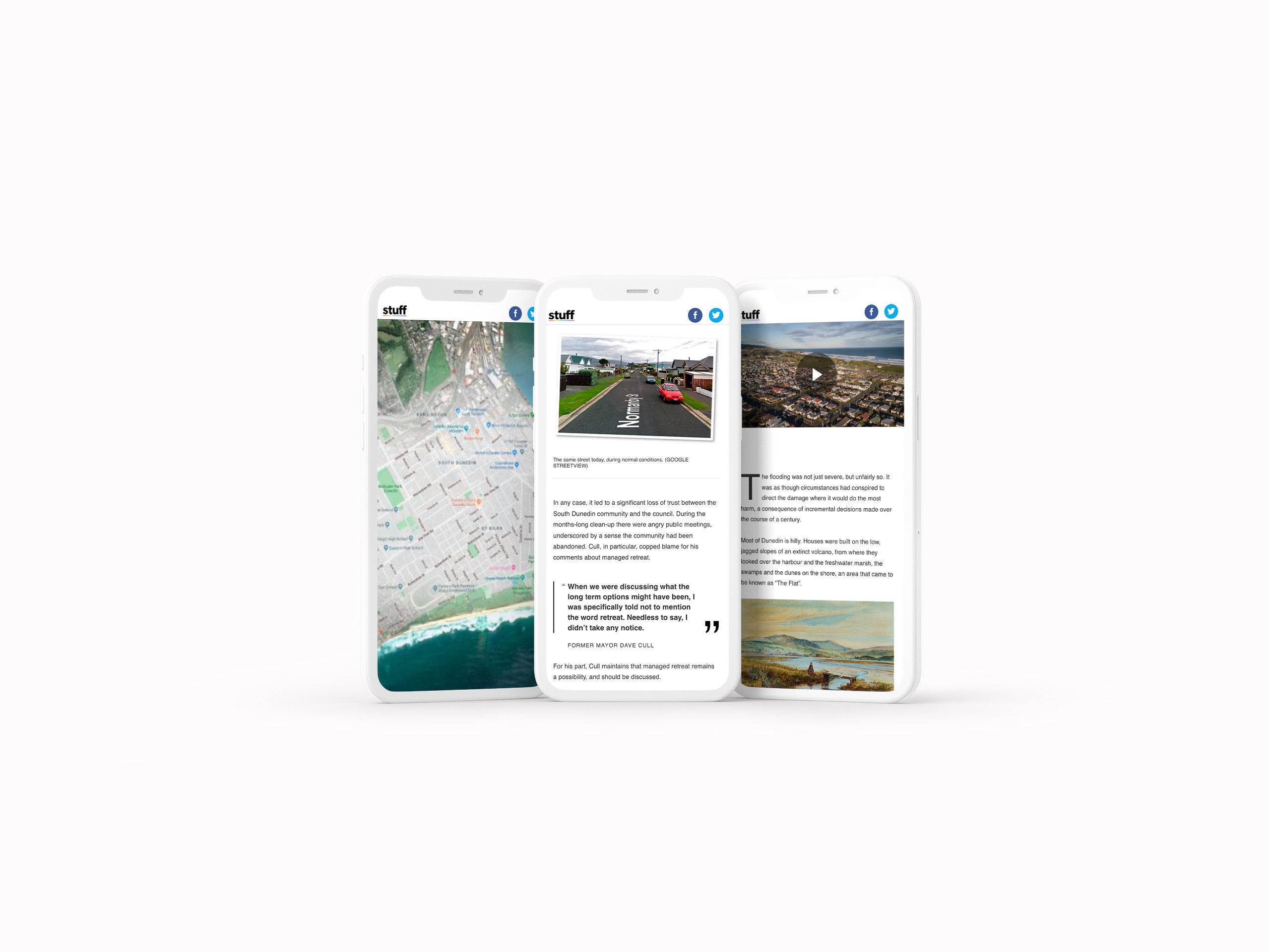
Displaced by the climate (Sky News)
This extensive piece of climate reporting from Sky News focused on how global warming is forcing people to leave their homes, all over the world.
It starts off on a global scale, with animated maps and charts that focus on data journalism. But then it zooms in on individual communities from Vanuatu to Boston. Each section is illustrated with timelines, photographs, and personal interviews that show the human toll behind the statistics.
The piece ends with a section titled “What can be done?” This isn’t just passive reporting; this is climate storytelling as a call to action.
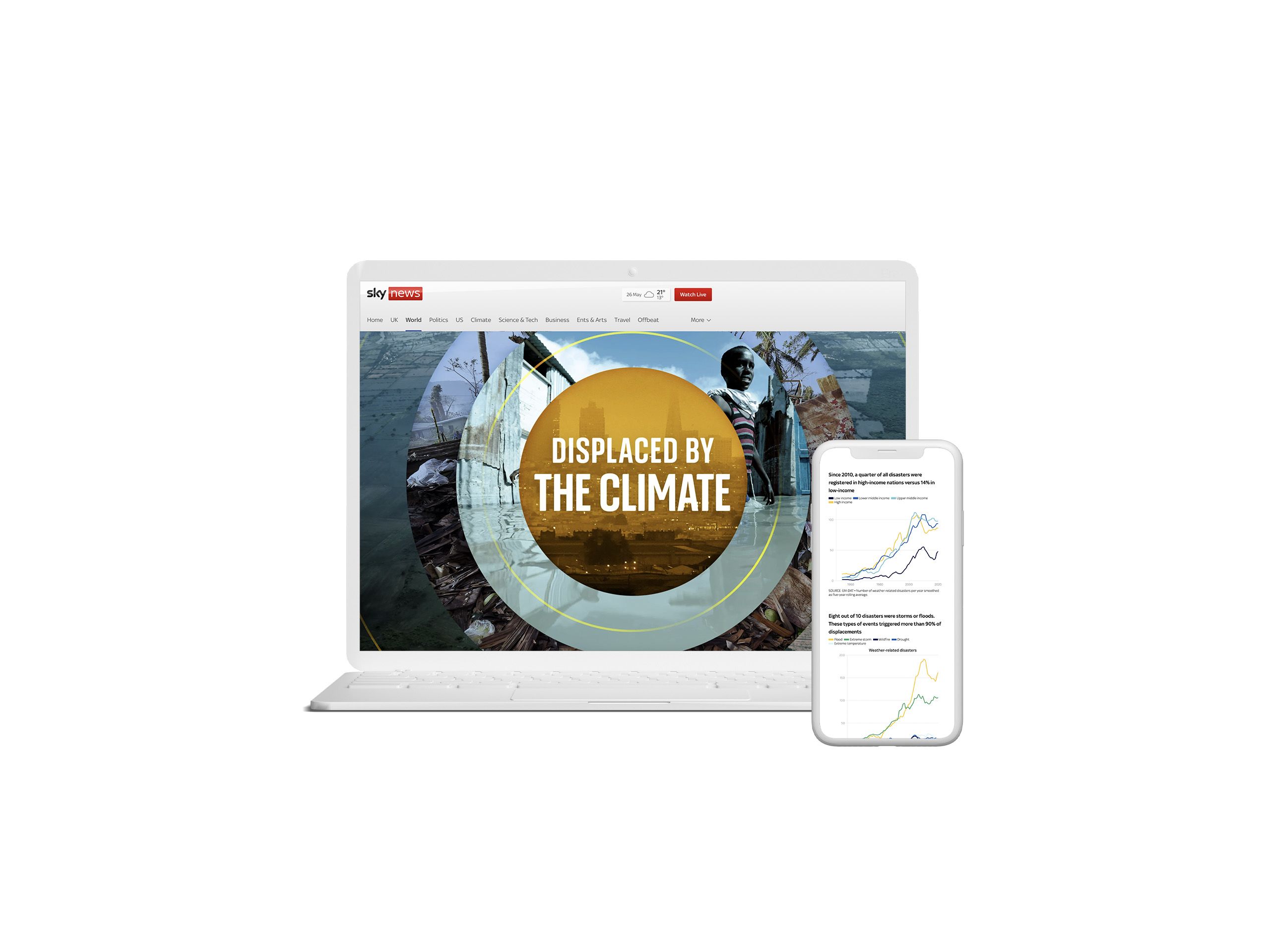

Climate stories: meet the people affected by extreme weather (WaterAid)
The title of this collection of climate change stories from WaterAid says it all. Instead of quoting facts and figures, they want you to meet the real people suffering the impacts of global warming, drought, and extreme weather.
Big, eye-catching images are overlaid with animations and diagrams that show how landscapes are being lost to droughts or flooding. In a reversal of the technique used by Sky News, this climate feature starts with personal stories, and then moves on to statistics and infographics later in the piece. It’s the same mix of scientific data and individual experiences, just presented in a different way to reflect the different aims of the NGO.
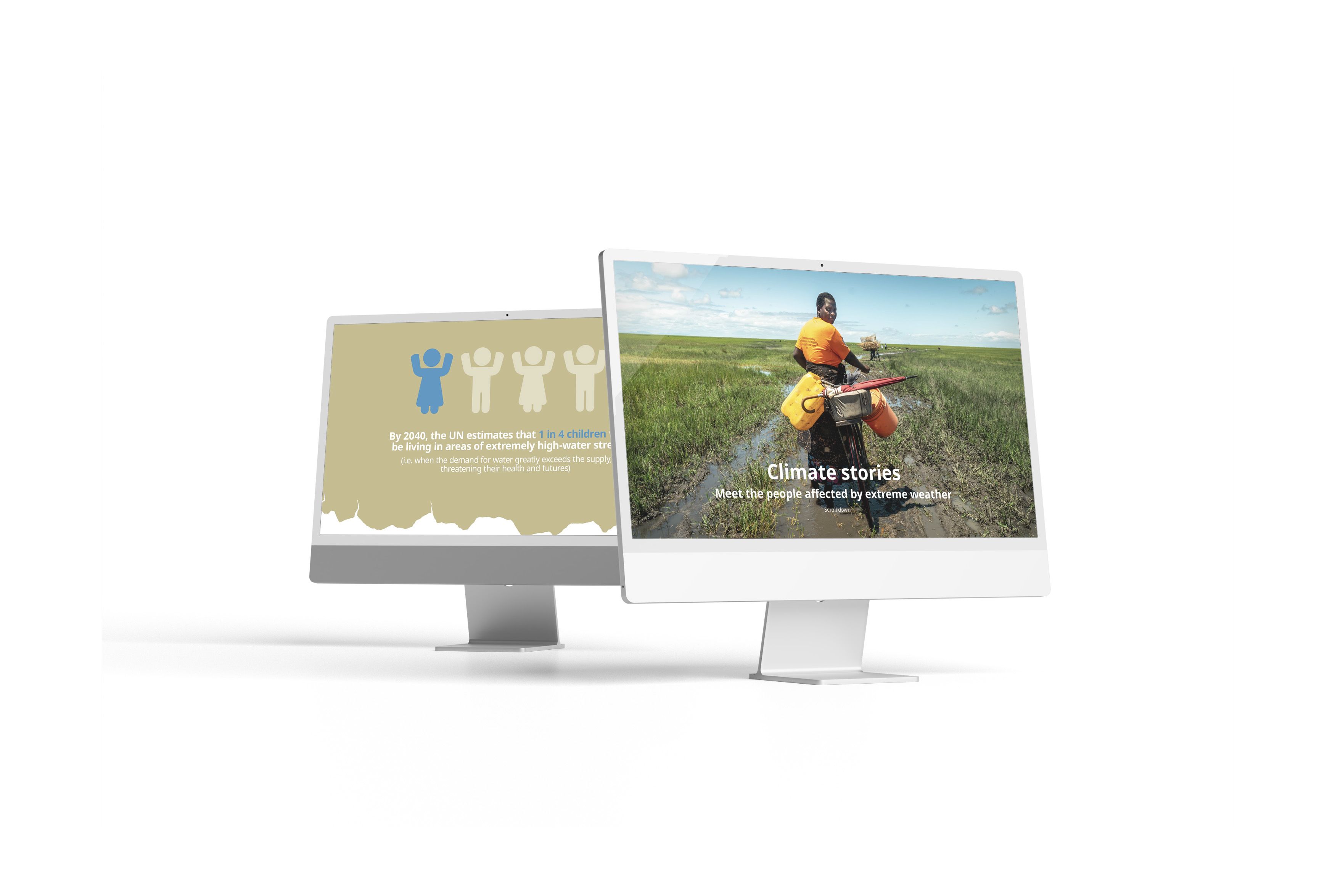
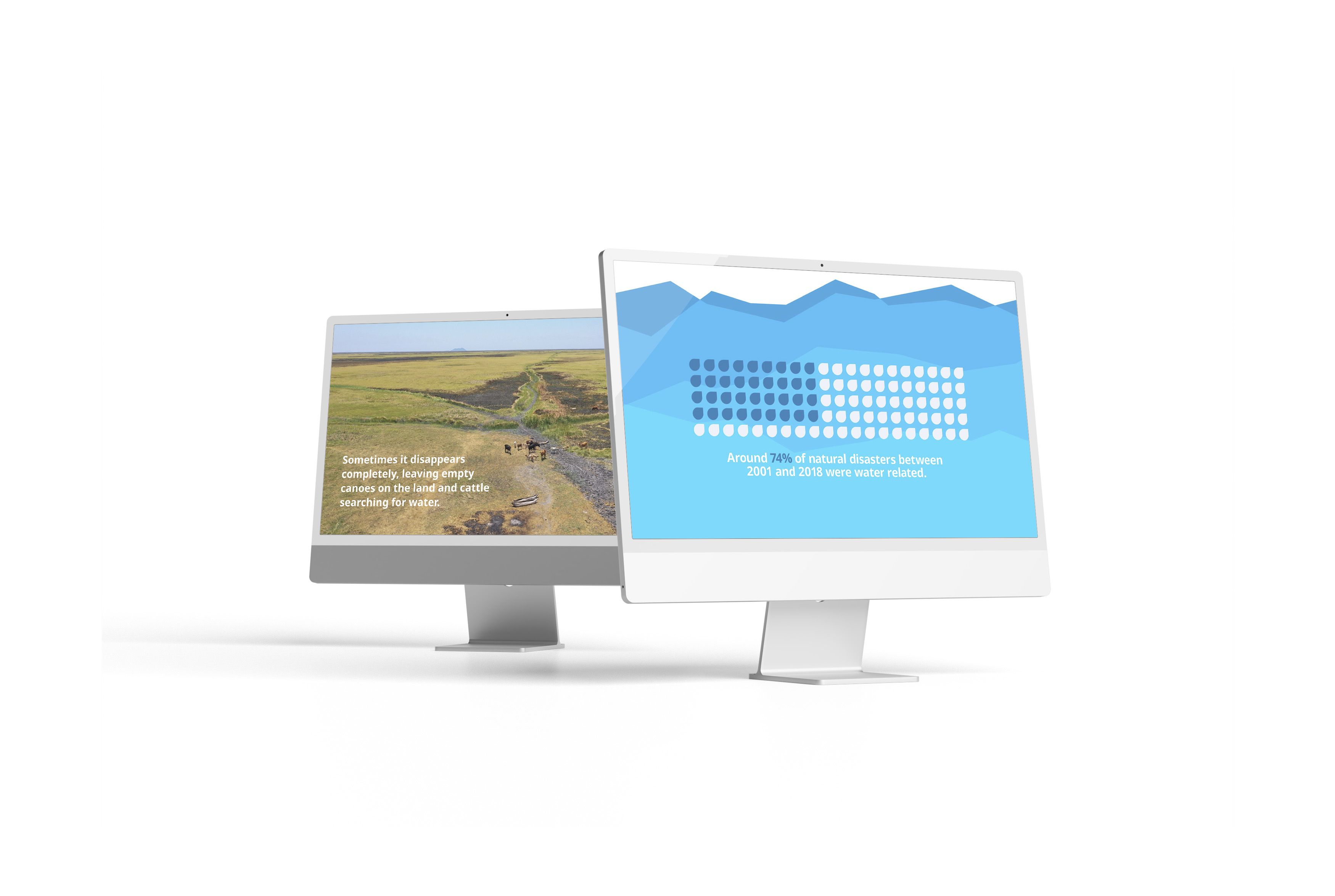
A growing toxic threat — made worse by climate change (NBC News)
Our next climate change story is a piece of investigative journalism from 2020, when scientists and campaigners were raising the alarm about the Trump administration’s approach to climate change in the US.
At a first glance, the climate feature is laid out like a classic front-page news story. There’s lots of whitespace and a dramatic lede.
But it also mixes in elements of the latest moves in digital publishing. The complex reporting and in-depth data behind the piece is made visible through photographs, animations, and maps and charts which can be toggled to show different data sets.
All the information is there, but it’s been presented in visual, interactive ways that help the reader to process the story on their own terms.

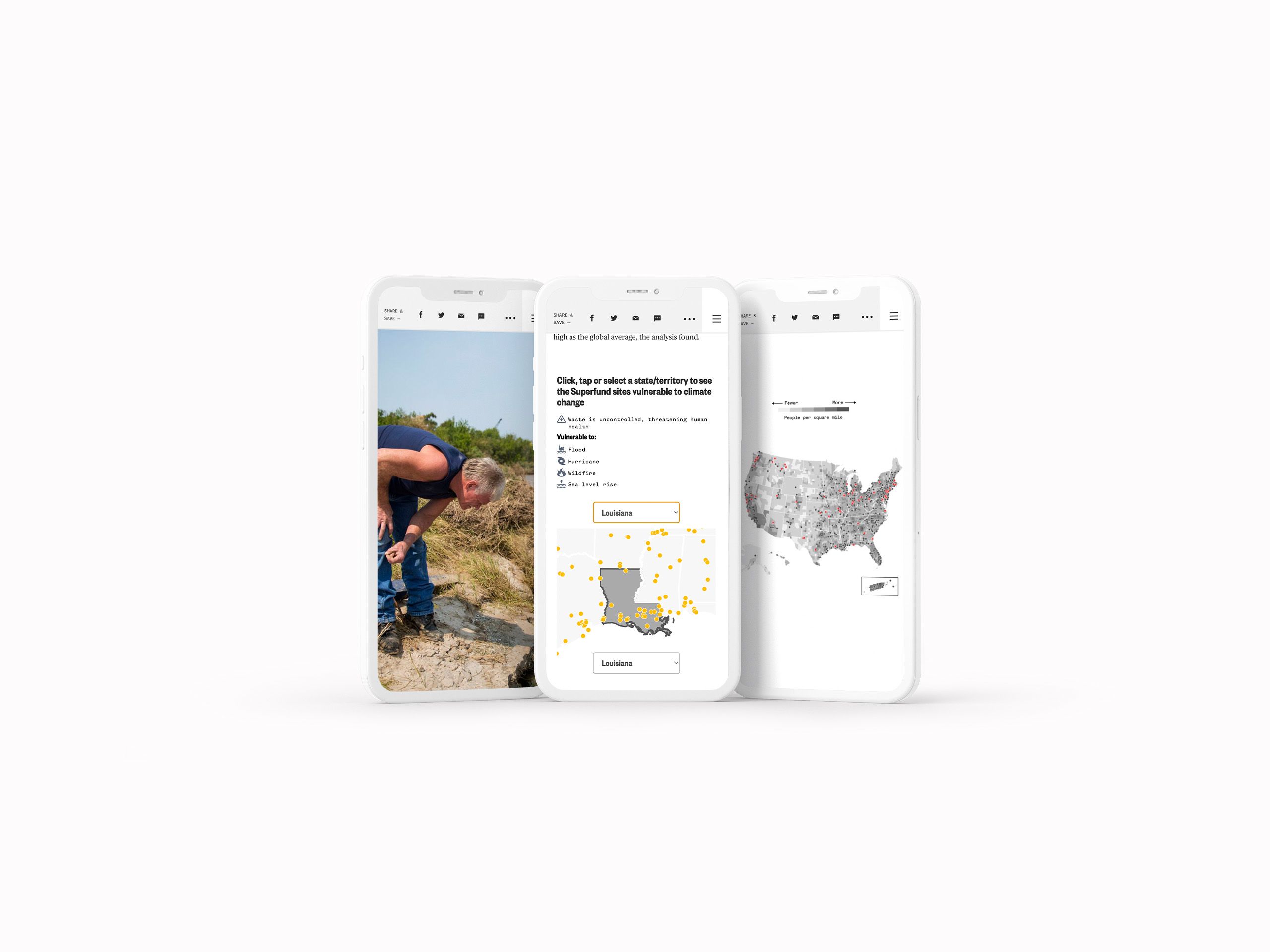
Meet the family on a mission to restore the desert eco-system (UNSW Sydney)
You can’t get more local than the story of a single family. This climate change story from the University of New South Wales highlights the efforts of two ecologists — and their small children — to reintroduce endangered native species to a degraded desert ecosystem.
Their work is fascinating in itself. But this article makes it even more gripping by talking about the challenges around their tasks: isolation, accessing medical care, and even finding a playgroup for their kids.
By framing the piece as a 'slice of life' article, the rigorous science and hard work behind the reintroduction project is made accessible and exciting.
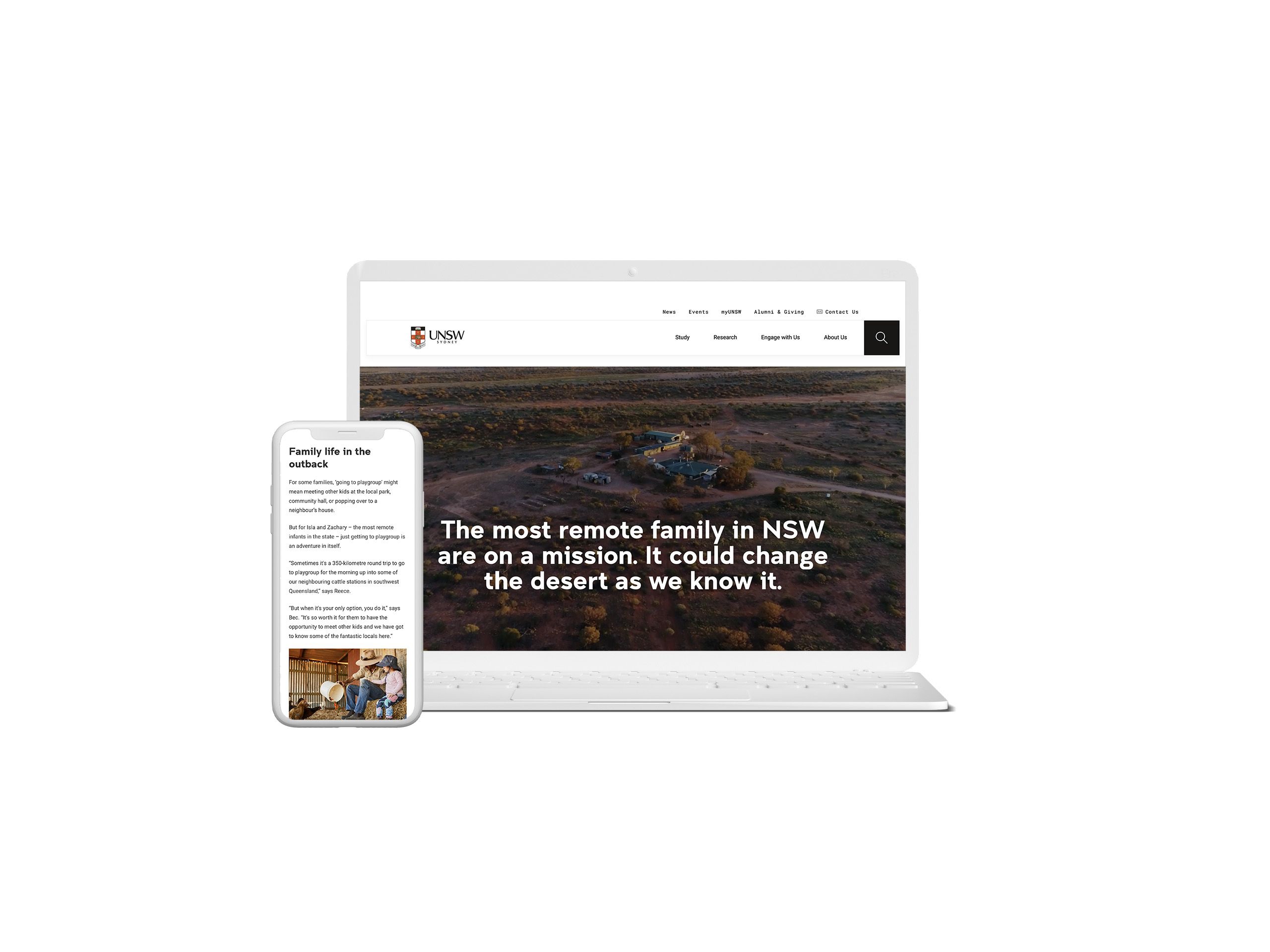
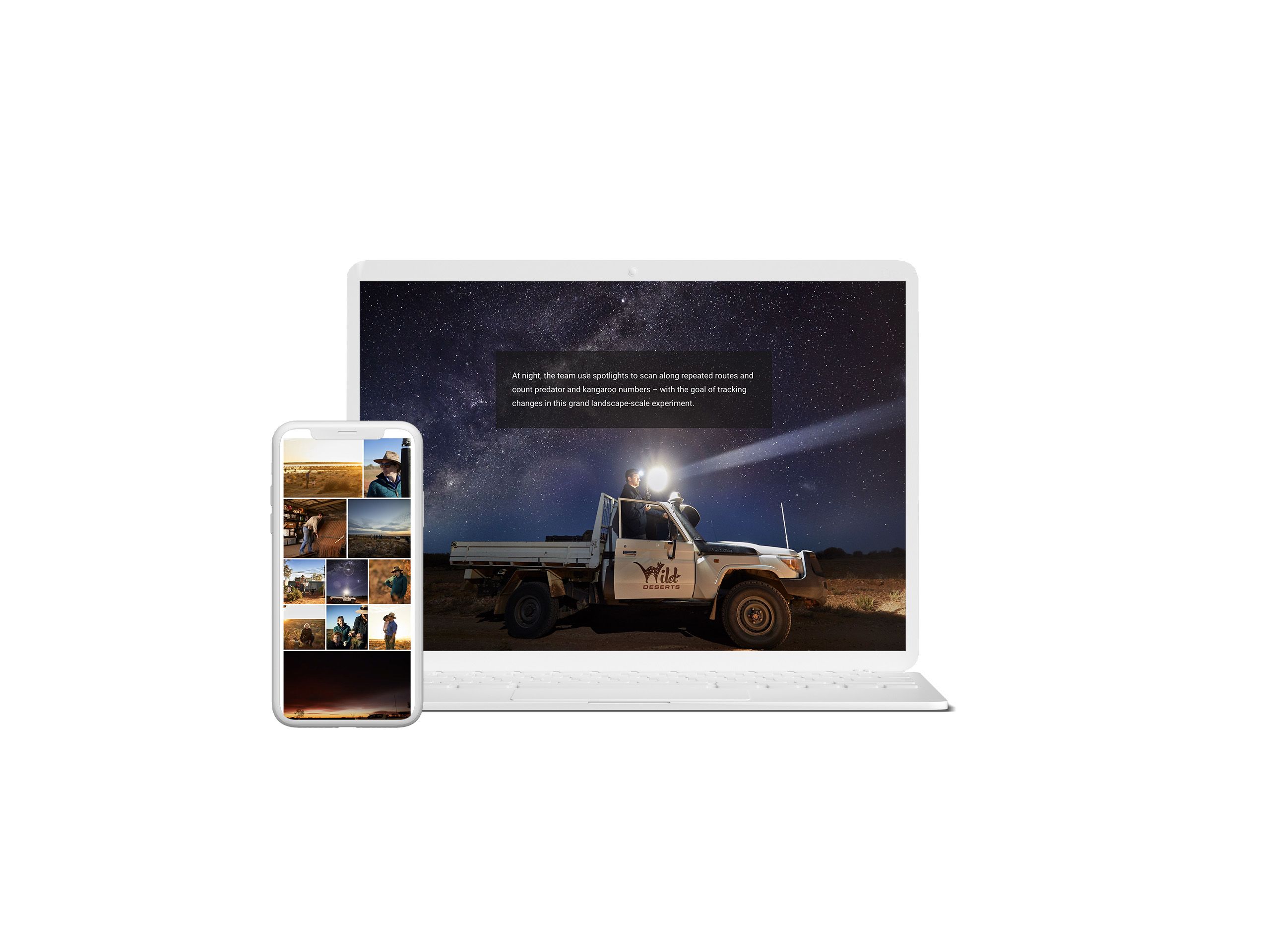
The people racing to replant Africa (Pioneers Post)
Many climate change stories focus on what’s happening on the Arctic and Antarctic poles. In this feature, Pioneers Post covers one of the most ambitious but least-known climate change stories: the Great Green Wall of Africa.
The plan has been in motion for several decades. Governments, NGOs, scientists, and local communities are working together to replant a vast zone across the continent and hold back the tide of desertification.
It’s a fascinating tale that mixes science, politics, and personal stories. And it’s been illustrated throughout with candid photos and portraits of the people who are responsible for growing the Wall.

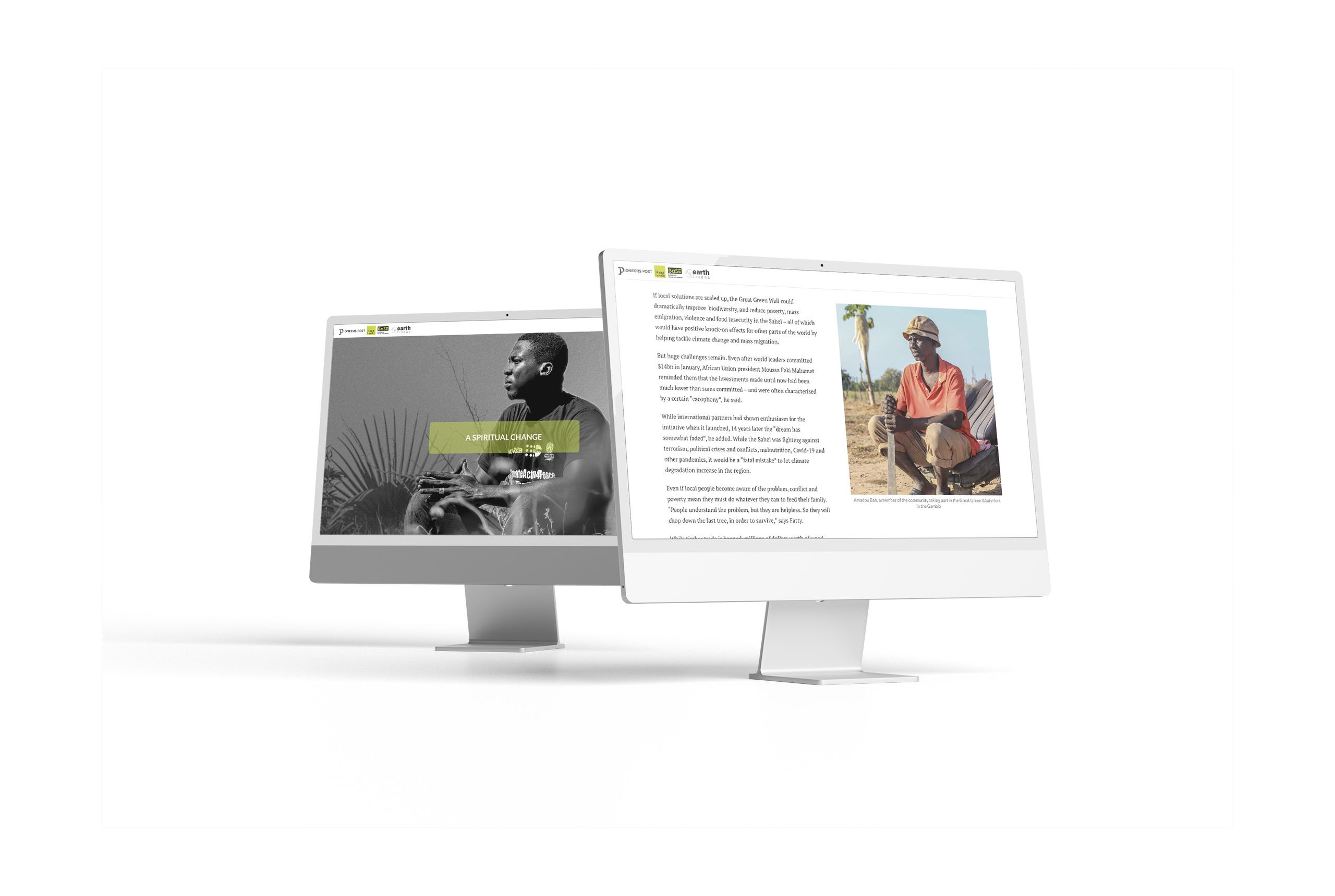
What the Olympics could look like in 2048 (WWF)
So far, we’ve seen examples of data journalism, climate change storytelling, and investigative reports. But here’s something a little different: a dispatch from the future.
In this climate change story, the WWF took the Olympics — a cultural reference point that belongs to everyone, all over the world — and imagined how sporting events would look if the climate emergency goes unchecked.
Glossy photos of pristine swimming pools and sports stadiums are suddenly choked with rubbish or covered by floodwaters. As readers scroll through the article, they see a horrifying glimpse of one potential future. Those images are backed by statistics and evidence from around the world.
However, we know that just showing the worst side of the climate emergency isn’t always motivating. That’s why the piece ends with a note of hope: an invitation to sign a petition addressed to world leaders and start taking action.

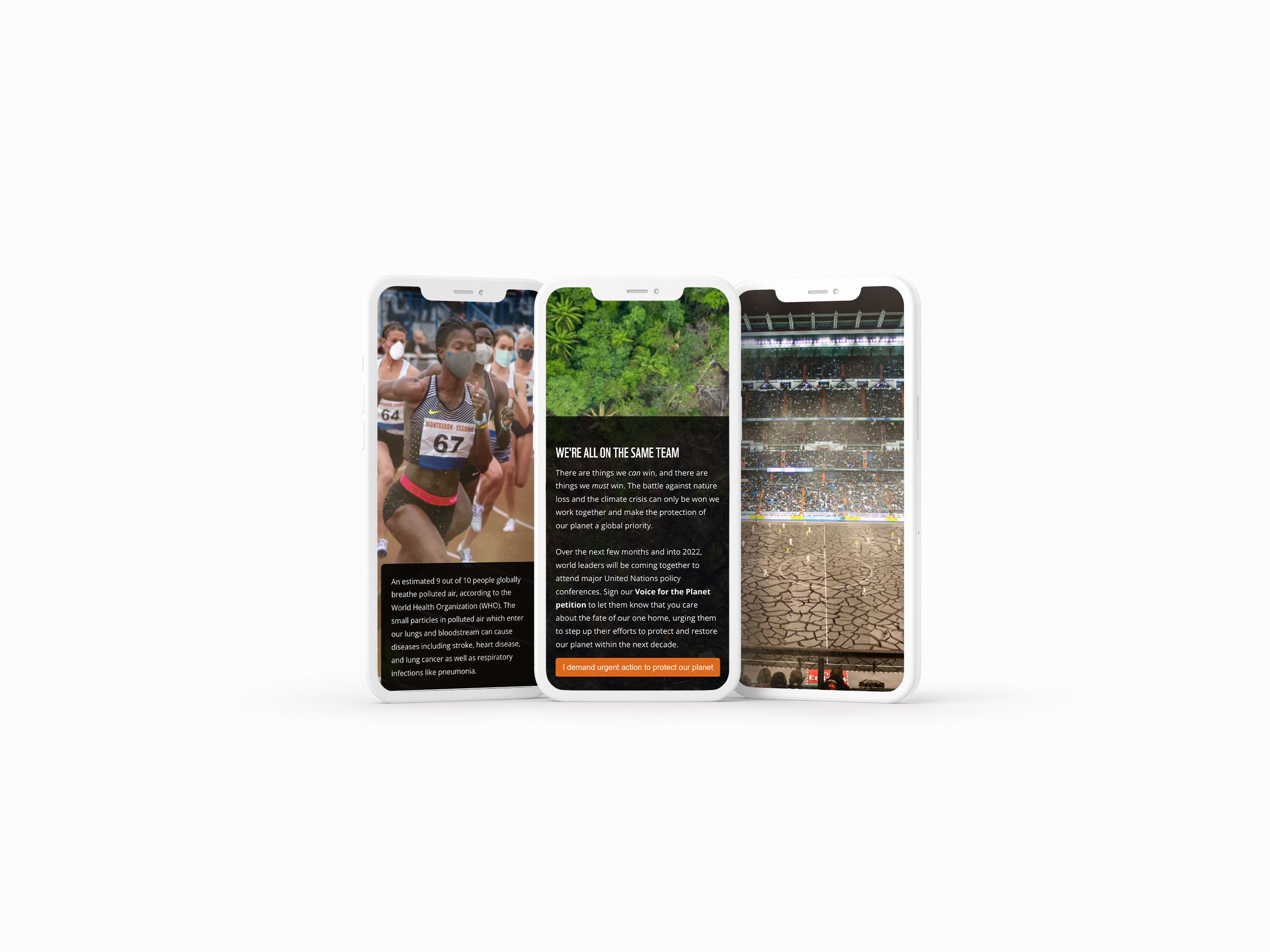
9 things you can do about climate change (Imperial College London)
A lot of climate coverage focuses on the macro, such as the latest IPCC report, the Paris Agreement, or government climate policy. This brief climate feature from Imperial College London isn’t just local, it’s personal. It’s about what you, the reader, can do to reduce global warming.
Sustainability tips range from leaving the car at home to investing in renewable energy sources, such as solar panels.
The piece goes straight for emotional appeal. It’s written in the second person, addressing readers as directly as possible. Each idea is illustrated with animations and supported with a range of links, so that you can get learning, donating, and campaigning right away.
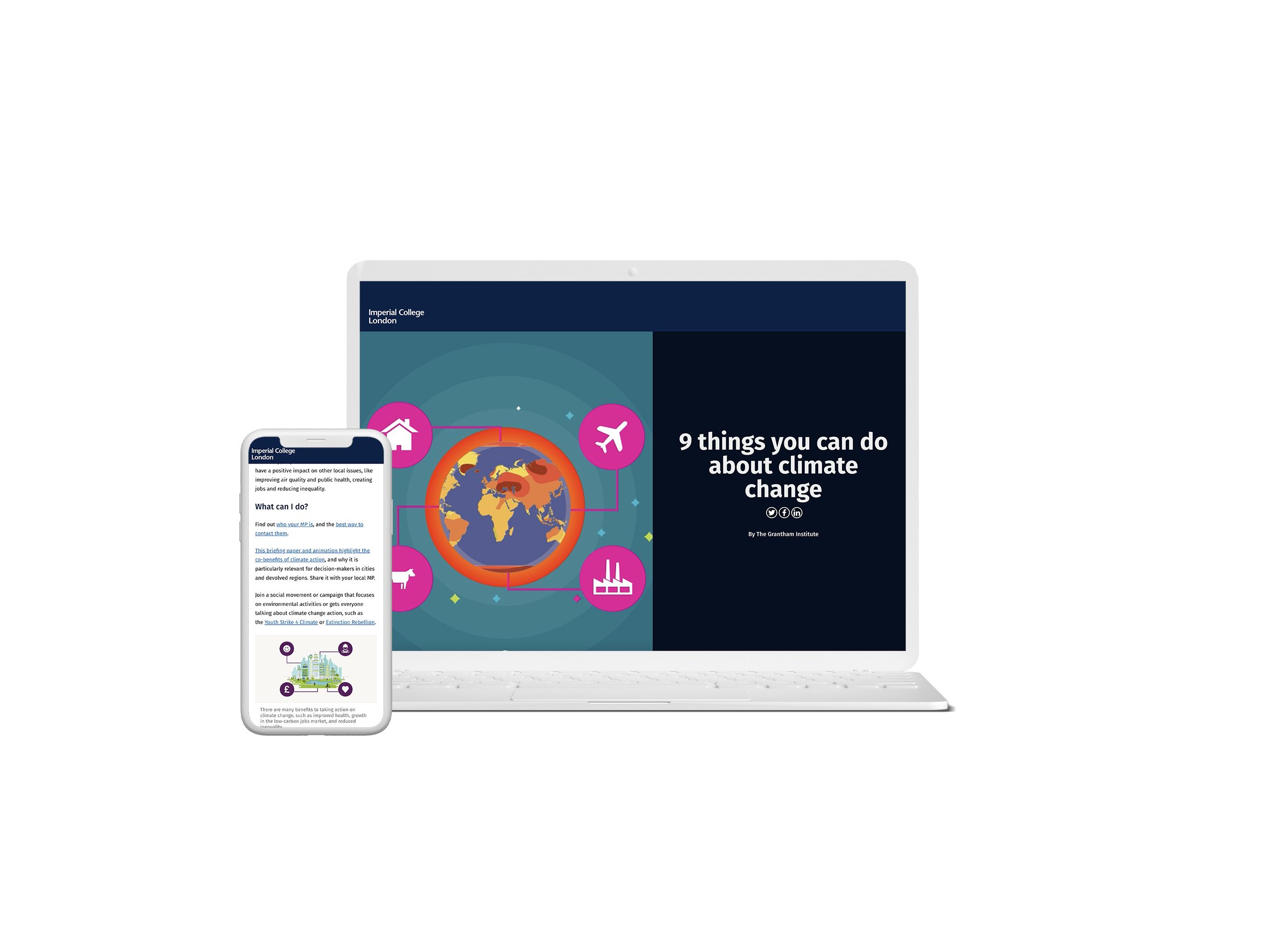
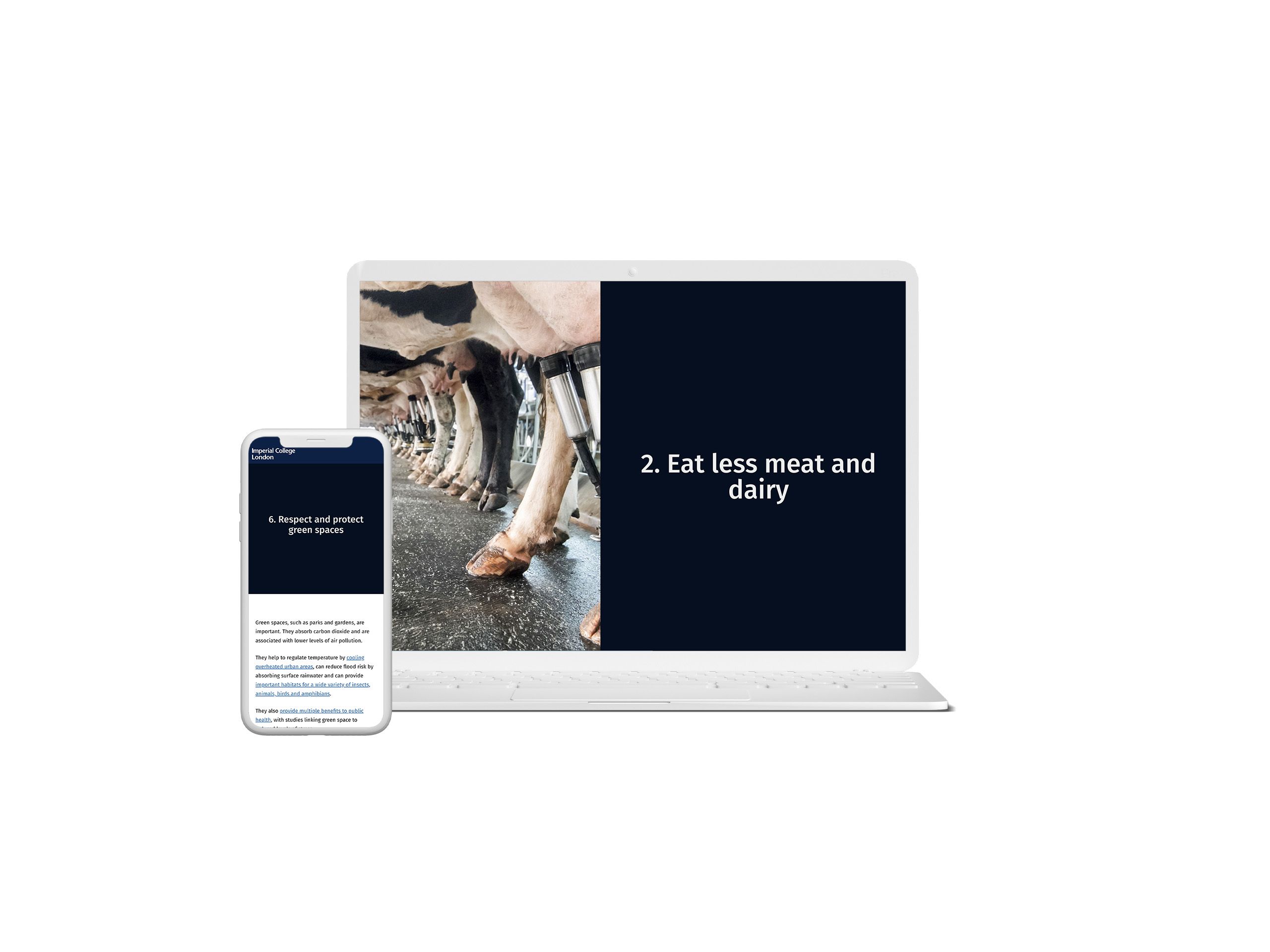
Glasgow: the last best hope to fight climate change (BBC)
This article brought the COP26 climate conference into focus by looking at the climate crisis from the perspective of the conference’s host city: Glasgow. The story of this industrial powerhouse is also the story of how human activity has transformed the environment and the climate.
The feature is illustrated with photographs from throughout Glasgow’s history. As you scroll down, black-and-white images from the last century are replaced with colourful images of the city today. Close-ups of antique paintings and modern blueprints show how people have imagined Glasgow’s future over time.
And, like the most effective climate change stories, the feature offers hope as well as a clear appraisal of the challenges ahead.
